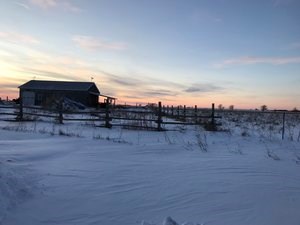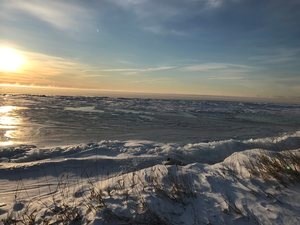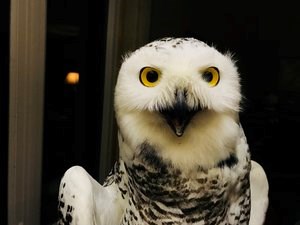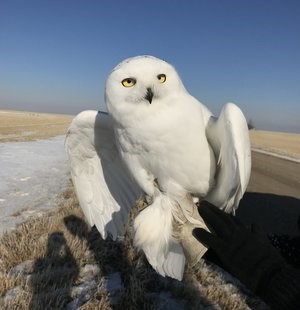A Back-to-Back Snowy Owl Adventure
Posted on in Blog by Rebecca McCabe, PhD Student, McGill University Hawk Mountain Research Assistant

It was 6:15 a.m., and the sun had not yet come up as we stepped from our cars onto the ferry deck on the ice-covered waters of Lake Ontario. We were on our way to Amherst Island, a 70 square-kilometer island off the coast of Kingston, Ontario, which is a known hotspot for wintering snowy owls and the reason why we were there.
Myself, Jean-François Therrien (Hawk Mountain), Tom McDonald (Rochester, NY), and Dave Okines (Prince Edward Point Bird Observatory) arrived on the island with the hopes of deploying transmitters on snowy owls as part of the collaborative research of Project SNOWstorm (www.projectsnowstorm.org).

As the sun finally rose, we were already driving the main roads searching for white silhouettes in the distance. Luckily for us, Amherst had plenty of snowy owls! We estimated over 25 owls on the island, and now all we had to do was trap a few. We came up short in the morning and afternoon, but as soon as the sun started to set, our luck changed. Within 20 minutes both Dave and Tom had trapped an owl.

We were fortunate to have a wonderful host, Janet, who allowed us to bring the owls back to her place so we could process them out of the cold. The two immature females, later named Emerald and Stella, were in good condition and each weighed over 2 kg making them eligible to receive a transmitter before being released back into the night.
In just a short amount of time we have learned that the neighboring birds established territories approximately 3 km from one another on the island, and Emerald has spent more time inland whereas Stella has been going offshore onto the ice during the day. I look forward to following these two individuals as they make their way north in the upcoming months.
One week and 2,370+ km later, I am scanning for snowy owls from the passenger seat again, but this time I am looking out on the prairies of Saskatoon, Saskatchewan. My co-supervisor Karen Wiebe (University of Saskatchewan) and I follow behind raptor bander Marten Stoffel in our pickup truck as we search the tops of telephone poles and fence posts. We spent six hours that day driving the survey route and had easily seen over 30 snowy owls. We were also very fortunate to trap and band six, a record day of trapping snowy owls on the prairies for Marten!

The next day we decided to go out again to see if luck was still on our side, this time driving about 150 km northeast of where we were the day before. I was shocked at the stark difference between locations and by the lack of owls we encountered on our second day. The habitat appeared similar but we only saw one adult male that afternoon. Marten decided to try trapping it, even though it was a more difficult catch with blustery winds and the male sitting high atop a transmission tower. Moments before calling it quits, I watched intently (and completely mesmerized) as the owl leapt from its perch and with a few strong flaps, came streaming in towards the bal-chatri before getting trapped.
Spending just a few days on Amherst Island and in Saskatoon and getting to see where these owls spend their winter was not only exciting but informative. I was able to observe them on their territories, take note of their favorite perches, and see first-hand the conditions they were in. As I move forward with my PhD at McGill University and analyze the movements of our GPS tagged snowy owls, my time spent in the field has allowed me to gain a better understanding of how these magnificent birds move throughout the landscape, the habitats they occupy, and the threats they face.

To learn more about these efforts or to support the project, visit hawkmountain.org/snowyowls.